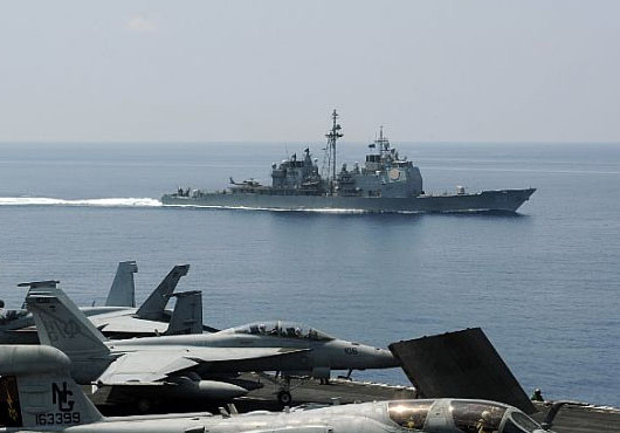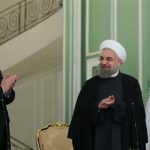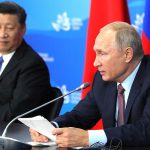by Walden Bello
The Philippines would seem to have won a major victory against China in a recent international court ruling in the Hague, which voided Chinese claims to parts of the South China Sea claimed by the Philippines and other Southeast Asian countries.
In a major rebuke of China’s claim to some 90 percent of the South China Sea, the tribunal’s Permanent Court of Arbitration completely rejected Beijing’s assertion that the land formations and waters in the area have historically fallen exclusively under the ambit of the Chinese state.
It’s said that the Hague judgment benefits not only the Philippines, but all the other Southeast Asian countries that claim other parts of the South China Sea. Some argue further that this establishes important precedents for settling maritime disputes among countries in all parts of the globe.
But the Hague verdict is not an undiluted victory for the Philippines. And at least in the short term, it will not unlock the door to peace in the region.
Not a Simple Territorial Dispute
The South China Sea row is not a simple territorial dispute. In fact, one can say that it stems principally from a fierce geopolitical rivalry between the United States and China, with the Philippines and other littoral states being collateral damage.
One cannot understand why China has acted the way it has without referring to the big shock the Chinese leadership received in 1996, when — after a period of 24 years of thawing and friendly relations with the United States — it was treated to a show of force of two aircraft carrier battle groups sent by the Clinton administration to warn it to back off during the Taiwan Strait Crisis. One of the carriers, the USS Nimitz, sailed provocatively through the Taiwan Strait. This was the largest display of U.S. military force in the region since the Vietnam War.
China’s apprehensions deepened when the George W. Bush administration, even prior to the 9/11 attacks, came out with a National Security Strategy Directive redefining China from a “strategic partner” to a “strategic competitor.”
A lot of the practical implications flowing from that redefinition were put on hold following September 11, as Bush tried hard to enlist Chinese cooperation in the war on terror. Yet many people at the Pentagon, the State Department, and the White House thought the war on terror and the Middle East adventures of the Bush administration were a distraction from what should be the real strategic thrust of U.S. policy — which was to focus on China as a chief strategic rival.
They finally got their wish when the Obama administration rolled out the “Pivot to Asia,” or Pacific Pivot — often characterized as a thinly veiled plan to contain China — as the grand U.S. strategy in the region.
Where China Went Wrong
A central element in Beijing’s response to what it regarded as “American encirclement” was to treat the South China Sea as part of its defensive perimeter. Where China went wrong was in its unilateral moves to implement this view.
Beijing knew that it shared these waters with at least six other littoral states, including Taiwan, with no agreed upon lines of demarcation. It was all too aware that the ASEAN countries had long been pressing for multilateral talks to define these borders. And it was not ignorant of the fact that detailed rules for the demarcation of territorial waters, exclusive economic zones, and navigation had already been incorporated into international law by the 1982 Convention on the Law of the Sea, which Beijing had ratified.
But despite knowing all this, Beijing began to move unilaterally, first slicing off and fortifying Mischief Reef, which lies within the 200-mile Exclusive Economic Zone of the Philippines, in the mid-1990s, on the pretext of building shelters for Chinese fishermen. That was followed by a comprehensive claim in 2009 that unilaterally asserted China’s “indisputable sovereignty” over all the islands and terrestrial formations in the South China Sea and their “adjacent waters/relevant waters.”
Accompanying Beijing’s note to the UN was the infamous “Nine- Dash Line” map. No official explanation for the Nine-Dash Line was provided at that time or since, though there have been unofficial references to the islands and waters of the West Philippine Sea as ancestral Chinese territories, or to their inclusion in old maps of the defunct Nationalist Chinese regime that date back to the late 1940s.
There are a number of reasons why China has behaved the way it has, but the central one is the strategic decision to make the area part of Beijing’s defensive perimeter against Washington’s encirclement. To achieve this goal, however, China resorted to the big power behavior it has so often criticized when displayed by the West, treating its neighbors as nothing but collateral damage of its increasingly sharp geopolitical rivalry with Washington.
China could have acted differently — for instance by working with ASEAN to craft a multilateral treaty to seal off the area from big power rivalry, along with the initiation of talks on a code of conduct to govern the behavior of parties with claims in the region. In fact, that was something that China and the ASEAN countries had agreed to negotiate in 2002.
Instead, Beijing chose the American way of unilateralism, cooking up nonexistent rights based on the most dubious documents.
A Fatal Contradiction
The Philippine government was right to bring the case to the Permanent Court of Arbitration in the Hague in January 2013, since the appropriate international legal instruments were present to resolve the case in accordance with the 1982 Convention on the Law of the Sea and other legal precedents.
For many intimately involved in the issue — including me, as a member of the Philippine Congress at that time — it was clear that the law was overwhelmingly on the Philippines’ side. We realized that while it was unlikely that China would immediately submit to a ruling by a Hague tribunal whose jurisdiction it did not recognize, we saw gaining international legal recognition of our rights and the moral authority that went with that as important assets in a struggle that would last for many more years.
But then the Philippine government went off the rails, allowing itself to be suckered into a military agreement with the United States that would again make the Philippines a major launching pad for the projection of U.S. power onto the East Asian land mass — to become part of the grand strategy proclaimed by the Obama administration as the “Pivot to Asia.”
I still have to figure out what went on in the minds of then Philippine President Benigno Aquino III and Foreign Secretary Albert del Rosario to account for their simultaneously pursuing a peaceful legal track in the Hague and a provocative military track aimed at containing the actor we wanted to convince to respect international law. Maybe they thought these two prongs were complementary. If this was the case, then it was a costly misjudgment.
The Philippines and the United States signed the Enhanced Defense Cooperation Agreement (EDCA) during President Obama’s visit to Manila in April 2014. This agreement of indefinite duration allowed the U.S. not only to rotate troops in the Philippines for training purposes, but also to deploy troops, weapons, and materiel in fixed bases that would be nominally Philippine-owned but where full operational control would be in the hands of the United States.
The Philippines’ main value to the United States has always been its being an ideal site for projecting power onto the Asian mainland, and Washington got this advantage again — over 20 years after Clark Air Base and Subic Naval Base were forced out of the county by a combination of a volcanic explosion and rising nationalism. With containment of China being Washington’s new grand strategy, the Philippines became one of the three prongs of U.S. strategy, the others being the U.S. bases in Japan and the mobile naval base known as the Seventh Fleet.
The Aquino administration sold EDCA to the Philippine public as a way of getting the United States to protect the territories we claimed in the South China Sea and our Exclusive Economic Zone. EDCA did not, in fact, provide this, and administration propaganda deliberately and deceptively omitted this fact. As far as Washington was concerned, it could not give the Spratly islands and terrestrial formations claimed by the Philippines defense coverage like it did to the Senkaku Islands claimed by Japan.
In fact, Washington’s oft-repeated response to the question of whether it recognized Philippine sovereignty over the islands is that it “does not interfere in sovereignty issues.” It might be pointed out here that Obama’s silence on the Spratlys during his visit to Manila in April 2014 contrasted with his explicit commitment to defend the Senkakus when he was in Japan just a few days earlier.
So what did the Philippines gain? Well, military aid, mainly in the form of World War II-era refitted U.S. coast guard cutters. Amazingly, the Aquino administration chose to forego even asking for rent for the bases the U.S. would use, whereas two decades back we extracted $180 million a year for the Washington’s use of Subic Naval Base, Clark Air Force Base, and several other installations. Even if one thought a military agreement with Washington was necessary — an assumption I strongly disagreed with — EDCA was a bad deal.
But there was a bigger problem with EDCA. Prior to the agreement, a number of us had warned Aquino that not only would we get no guarantee of defense of our South China Sea possessions from Washington, but we would be farther away from a resolution of the territorial issue if we signed on to EDCA.
Why? Because the dynamics of superpower competition between China and the U.S. would marginalize the territorial question. Before EDCA, we were small but we were significant. Through EDCA, though, we transformed ourselves into the pawn of one party in a superpower struggle. Vietnam and Malaysia had their differences with China — and even outright skirmishes in the case of Vietnam — but China saw them as neighbors, perhaps troublesome, but neighbors nevertheless.
By signing on to EDCA, we graduated into a different category: that of an ally of China’s strategic rival. Having deviated from the legal-diplomatic route — the only viable one — by entering into a military alliance with a state determined to contain China, the moral force and diplomatic credibility the Philippines should have gained from its legal victory in the Hague has been compromised. Beijing will besmirch Manila’s legal triumph by branding the Philippines as Washington’s gofer in its grand strategy of encircling China.
Where Do We Go From Here?
The new administration of President Rodrigo Duterte has been rightfully sober in its response to Hague decision, welcoming it but not furiously waving the flag.
The new government is right to be circumspect, since it received a problematic legacy from the previous administration: a successful legal appeal compromised by a provocative military alliance. How should it approach China on the South China Sea issue?
I do not believe in the inevitability of trends. A combination of openness to reexamining our premises, experimenting with a different strategy, and luck could turn things around, though one must admit it’s not going to be easy.
Let’s say that Beijing is concerned enough about its international image to see the disadvantages of being intransigent, especially as it seeks to be respected as a superpower not bent on destabilizing the global status quo. And let’s also stipulate that China would prefer a future of peace with its neighbors to one of endless tension that could occasionally break out in open conflict.
If those facts hold, here are some possible steps towards a settlement.
First, since it is the military element that is fundamentally driving China’s behavior, the Philippines and China can agree to have bilateral talks on how to bring down the tension between the countries. The aim of the these talks will not be to settle the territorial issue but to negotiate military de-escalation. One possible proposal could be a freeze in China’s base-building activities in exchange for a freeze in the implementation of EDCA. Though the focus of the talks would not be on the maritime dispute, some mention of it would be inevitable, which is why it would be wrong for China and unacceptable to the Philippines to make no reference to it a precondition for the negotiations.
Second, perhaps simultaneously with the Philippine-China bilateral talks, ASEAN and China can start the long postponed multilateral talks on a code of conduct to govern the maritime behavior of all parties with claims to the South China Sea that they agreed to have in 2002.
Third, should these two confidence-building measures achieve some success, ASEAN and China could move on to negotiations to achieve significant demilitarization and denuclearization of the South China Sea, with the goal of coming up with a multilateral treaty that would be binding on all parties, including third parties like the United States.
Such an agreement would, of course, necessitate abandoning EDCA on the part of the Philippines and dismantling of military structures in the South China Sea on the part of China. This agreement would complement two earlier ASEAN agreements — the agreement to make ASEAN a Zone of Peace, Freedom, and Neutrality (ZOPFAN) and the Southeast Asia Nuclear Weapons Free Zone Agreement (SEANWFZ). It could also be the forerunner of an East Asia-wide collective security treaty that would replace the dangerous and volatile balance of power politics that simply promotes an uncontrollable arms race.
Finally, ASEAN and China could begin the process of resolving their competing claims on Exclusive Economic Zones and continental shelves and discussing joint development of fisheries and other resources. Given political sensitivities, these might be de facto arrangements instead of full-blown treaties or agreements, and would not necessitate China’s formally abandoning its Nine-Dash-Line claim — at least not in the short term.
Manila’s diplomacy must be anchored on the Hague decision affirming its rights in the West Philippine Sea, but this must be combined with distancing ourselves from Washington’s military containment strategy, very close cooperation with ASEAN neighbors, and a willingness and patience to go the distance in dealing with Beijing.
Filipinos and Chinese are, after all, both Asians — peoples separated by colonialism, imperialism, the Cold War, and the continuing hegemonic schemes of forces external to the region. It’s time both sides commit to bridge that separation, no matter how difficult initially that process might be. The time for flag-waving and false solutions is over. It’s time for serious engagement.
Reprinted, with permission, from Foreign Policy In Focus. Photo: USS John C. Stennis Operates in the South China Sea (courtesy Times Asi via Flickr)
FPIF columnist Walden Bello served as a member of the House of Representatives from 2009 to 2015. He broke with the administration of President Benigno Aquino III partly over issues related to the Philippines’ relations with the United States. His resignation from the House in March 2015 is said to be the only resignation on principle in the history of the Congress of the Philippines.






This is an astonishingly comprehensive and literate report! I hope that new President Duterte reads it carefully and with openness. China too! No hope here that the US might sit up and take notice….